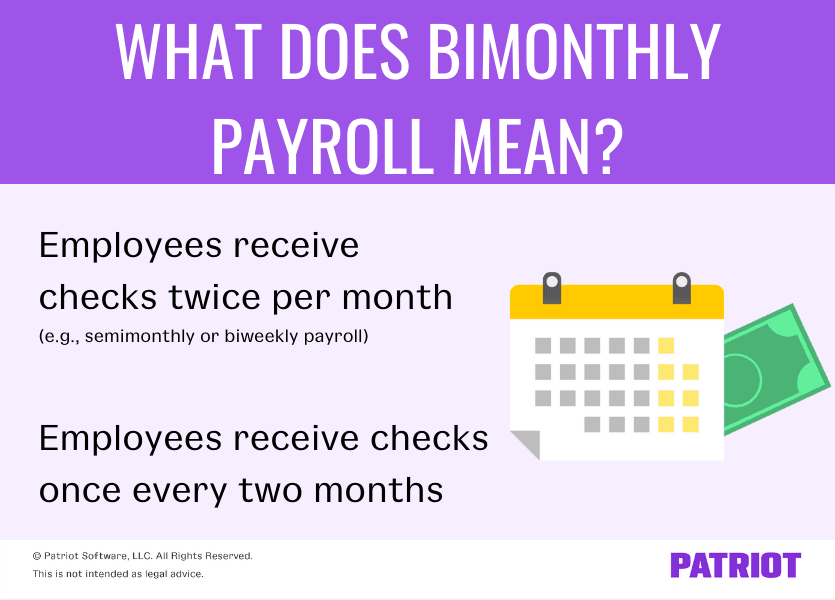You’re trying to figure out a decent pay frequency for your business. There are a number of popular options, like weekly payroll, and some that are a little more out there, like bimonthly payroll.
Have you ever heard of bimonthly payroll? If you have, would you consider it for your small business?
You may not get the chance to make that choice. Read on to learn exactly what a bimonthly payment schedule is, common misconceptions about it, and whether you can use it to pay your workers.
What is bimonthly payroll?
Before running payroll, you need to select a pay frequency. Your pay frequency determines how often you’ll pay employees throughout the year.
Generally, there are four main pay frequencies businesses can choose from:
- Weekly
- Biweekly
- Semimonthly
- Monthly
But wait! There’s no mention of bimonthly payroll. So, what is it? Is it a legitimate payroll option? Well, it depends.
According to Merriam-Webster, bimonthly can mean one of two things:
- Twice per month
- Once every two months

Depending on how you define bimonthly payroll, it can be synonymous with semimonthly or biweekly payroll, meaning you (generally) pay your workers twice per month. Or, it can mean that you’re trying to pay employees once every two months … which might be a bit of a stretch.
Let’s break it down one more step. If you define bimonthly pay periods as being twice per month, what’s the difference between biweekly vs. semimonthly payroll?
A biweekly pay schedule means employees receive 26 paychecks per year. This means you run payroll once every two weeks on consistent days of the week (e.g., Fridays). Two months during the year, employees receive three paychecks in a month.
On the other hand, a semimonthly pay schedule means employees receive 24 paychecks per year. Semimonthly means that you pay employees two times per month on specific dates (e.g., the 15th and 30th of the month).
So if you hear the phrase “bimonthly payroll,” someone might be combining biweekly and semimonthly pay schedules.
Are bimonthly pay periods legal?
Before deciding to set a bimonthly pay schedule, first make sure that it’s legal. Learn about pay frequency requirements by state for both definitions of bimonthly payroll below.
Bimonthly—twice per month
In most states, paying employees twice per month is perfectly legal. However, some states don’t allow semimonthly payroll or both semimonthly and biweekly payroll.
Semimonthly payroll rules
According to the Department of Labor, the following states do not let employers set semimonthly payroll schedules:
- Connecticut
- Massachusetts
- New Hampshire
And, some states that generally allow semi-monthly payroll schedules have special rules in place. For example, employers in New York can pay workers using a semimonthly frequency upon approval.
Biweekly payroll rules
Like semimonthly payroll, biweekly schedules are generally accepted. However, two states do not allow it:
- Connecticut
- Massachusetts
Again, other states that allow biweekly payroll may have specific rules in place. For example, Michigan pay frequency rules depend on occupation.
Bimonthly—once every two months
Things get a little dicier when you define bimonthly payroll as paying your employees once every two months.
Most states ban bimonthly pay periods. However, four states do not have pay frequency regulations in place.
The following states do not require employers to use a specific payroll schedule:
- Alabama
- Florida
- North Carolina
- South Carolina
If your employees work in one of the above four states, you should still contact your state to verify you can run bimonthly payroll.
What about taxes?
Another thing you need to consider if you run payroll once every two months is how you’ll handle employment taxes.
Federal income and payroll taxes are due either monthly or semiweekly. Keep this in mind if you think paying your workers once every two months is a good idea.
Bimonthly payment schedule: Some food for thought
There are three main things you need to remember if you want to give employees a bimonthly paycheck:
- Your definition of bimonthly (i.e., twice per month or once every two months)
- If it’s allowed (what does your state have to say about it?)
- How you’ll handle tax deposits if you pay employees once every two months
Instead of paying employees once every two months, remember that you can select a more frequent pay schedule (e.g., weekly, biweekly, semimonthly, or monthly). Choosing a generally accepted frequency can not only help keep your employees happy, but it can also keep things legal.
Go ahead, pick a payroll frequency that works for your business. With Patriot’s online payroll, we won’t charge you each time you run payroll. So whether you run payroll weekly or monthly, you’ll pay the same low rate. Start your free trial now!
This article has been updated from its original publication date of
This is not intended as legal advice; for more information, please click here.




